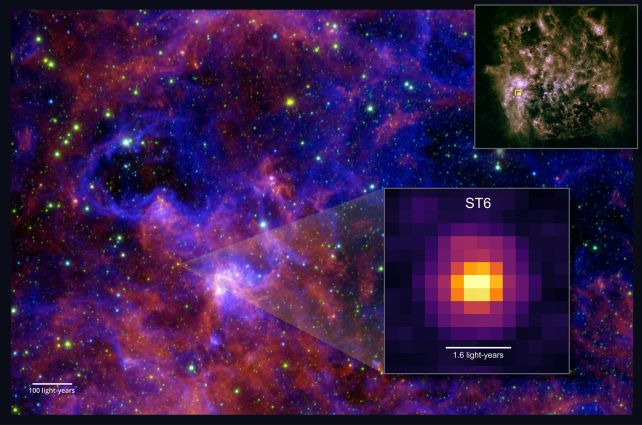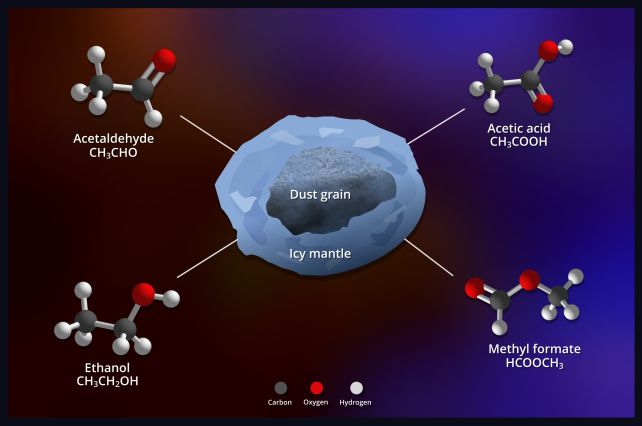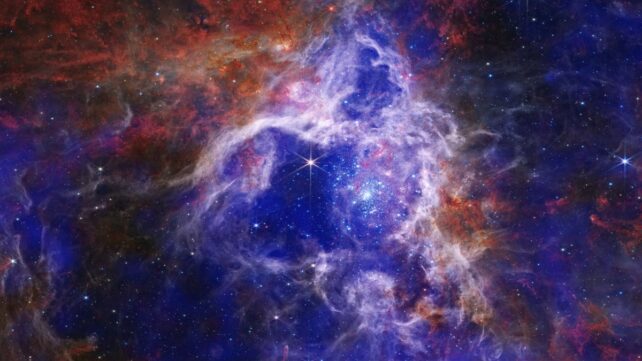For the first time, astronomers have seen life's building blocks in ice beyond the borders of our galaxy.
Among a mix of complex organic molecules trapped in ice circling a newborn star in the Large Magellanic Cloud, researchers found ethanol, acetaldehyde, and methyl formate – compounds that have never before been spotted in ice form outside the Milky Way.
Moreover, another identified compound, acetic acid, has never before been conclusively identified in ice anywhere in space.
The discovery, led by astrophysicist Marta Sewiło of NASA's Goddard Space Flight Center and the University of Maryland, suggests that the ingredients for the chemistry that gives birth to life are widespread and robust across the cosmos, and not limited to our own galaxy.
Related: Key Ingredient For Life Discovered in The Last Place Astronomers Expected
"With this discovery," Sewiło says, "we've made significant advancements in understanding how complex chemistry emerges in the Universe and opening new possibilities for research into how life came to be."

Complex organic molecules (COMs) in an astrophysical context are molecules with at least six atoms, at least one of which is carbon. The category includes molecules such as ethanol (CH₃CH₂OH), methyl formate (HCOOCH₃), and acetaldehyde (CH₃CHO), as well as larger molecules such as iso-propyl cyanide ((CH3)2CHCN).
They're important to scientists because they're the chemical precursors to the molecules that build life, such as amino acids, sugars, and nucleobases. Finding them in space, therefore, sheds light on the origins of prebiotic chemistry and where those precursor compounds were likely forged before Earth was even born.
Scientists also want to know if there are differences in the distribution of molecules based on their location. The Large Magellanic Cloud (LMC) is a very different environment from the Milky Way. It has about a third to a half of the heavy metal abundance; in astronomy terms, that means anything heavier than helium, so the LMC has less oxygen, carbon, and silicon, for example.
It also has much less dust to block light, and relatively intense star formation that floods the galaxy with ultraviolet radiation. Naturally, this raises questions about how COMs form within the LMC.
One such young star, called ST6, is situated about 160,000 light-years from Earth in a superbubble called N158 – not far from the famous, star-forming Tarantula Nebula. Sewiło and her colleagues turned JWST's golden compound eye to this star, soaking up the mid-infrared light from the icy material swirling around it to identify the chemistry taking place therein.
They then compared the spectra they obtained to a known "COM fingerprint" – a database of the signatures of various COMs. These molecules absorb light at specific wavelengths, which produces shadowy lines on the spectrum that scientists can match to known molecules.
In the light collected by JWST from the icy dust around a star in another galaxy, the researchers made confident detections of methanol, acetaldehyde, ethanol, methyl formate, and acetic acid (CH₃COOH).

Prior to this detection, acetic acid had only ever been found in space in vapor form. Discovering it in its frozen form backs up computer models and lab experiments that have suggested it participates in grain-surface reactions thought to build prebiotic compounds in space.
In fact, the presence of all these molecules provides some pretty strong evidence that they are the products of grain-surface chemistry. This is where ice forms on dust grains in space, generating thin coatings that cover each tiny mote. Aided by radiation, grains within this ice can move around and react with each other, forming the COMs the team found.
Here in the Milky Way, that would be interesting enough; but the results here suggest that even in metal-poor conditions lashed with radiation like the LMC, this process can still take place.
The researchers plan to expand their work to more young stars in the LMC to determine whether similar chemistry takes place across the entire dwarf galaxy, or if ST6 is an outlier.
"We currently only have one source in the Large Magellanic Cloud and only four sources with detection of these complex organic molecules in ices in the Milky Way," Sewiło says. "We need larger samples from both to confirm our initial results that indicate differences in COM abundances between these two galaxies."
The research has been published in The Astrophysical Journal Letters.

